| View previous topic :: View next topic |
| Author |
Message |
lluis
Joined: 17 Nov 2006
Posts: 719


|
 Posted: May 20, 2017 04:34 Post subject: Re: Herkimer quartz - Balochistan, Pakistan Posted: May 20, 2017 04:34 Post subject: Re: Herkimer quartz - Balochistan, Pakistan |
|
|
Hi, Roger
NH3 is normally from biotic origin, through decomposition of any nitrogen compound that could bring down ammonia.
Copper sulfate, even if saturated, as you can see in the video is far paler in color than the inclusions in the quartz cabochon. At least in my screen. And done that are not so thick than the vase, well, it should be a copper complex, that looks as an amino compound. That are not found in nature (the ammonium copper salts.....), as far as I know. The ones in Chile as far as I remember where methyl amino copper complexes (I think found in a place where guano was present, so, the source is biotic also
Anyway, without an analysis, we could not ever know if the inclusions are a copper salt...
Then, theorizing about an unknown, is just theory....
Hi, Don
I have also not the subscription....
But, if fluorescent under UV, seems me not a copper salt....
Anyway, it looks blue, and could be an hydrocarbon, colored by anything (as the blue amber from República Dominicana...)
But, without analysis, well, .... :-(
With best wishes
Lluís
|
|
| Back to top |
|
 |
cascaillou
Joined: 27 Nov 2011
Posts: 263


|
 Posted: May 25, 2017 13:33 Post subject: Re: Quartz Inclusions Posted: May 25, 2017 13:33 Post subject: Re: Quartz Inclusions |
|
|
Those blue fluid inclusions have not been reported to fluoresce.
I was told it was copper based, but otherwise I could have thought of cobalt.
|
|
| Back to top |
|
 |
cascaillou
Joined: 27 Nov 2011
Posts: 263


|
 Posted: May 26, 2017 10:53 Post subject: Re: Quartz Inclusions Posted: May 26, 2017 10:53 Post subject: Re: Quartz Inclusions |
|
|
A few more pictures of my specimen...
| Mineral: | Quartz with petroleum inclusions |
| Locality: | | Balochistan (Baluchistan), Pakistan |  |
|
| Dimensions: | 1.9x1.4x1.2cm |
| Description: |
| Shot in sunlight. Besides yellow petroleum, note black asphaltite and moving gas bubble. |
|
| Viewed: |
35609 Time(s) |
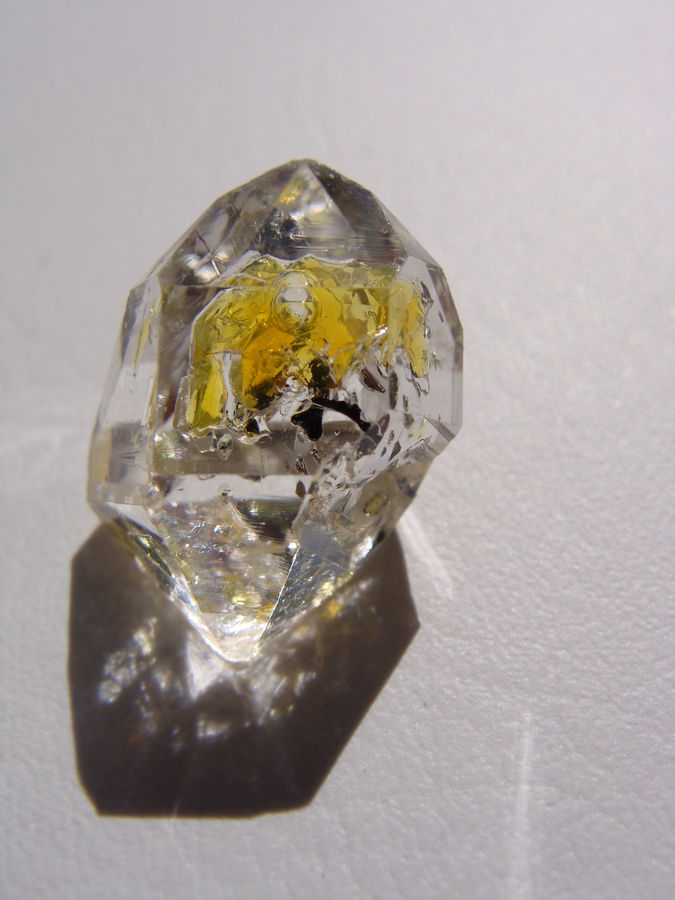
|
| Mineral: | Quartz with petroleum inclusions |
| Locality: | | Balochistan (Baluchistan), Pakistan |  |
|
| Dimensions: | 1.9x1.4x1.2cm |
| Description: |
| Shot under long wave UV. Petroleum showing bluish fluorescence. |
|
| Viewed: |
35617 Time(s) |
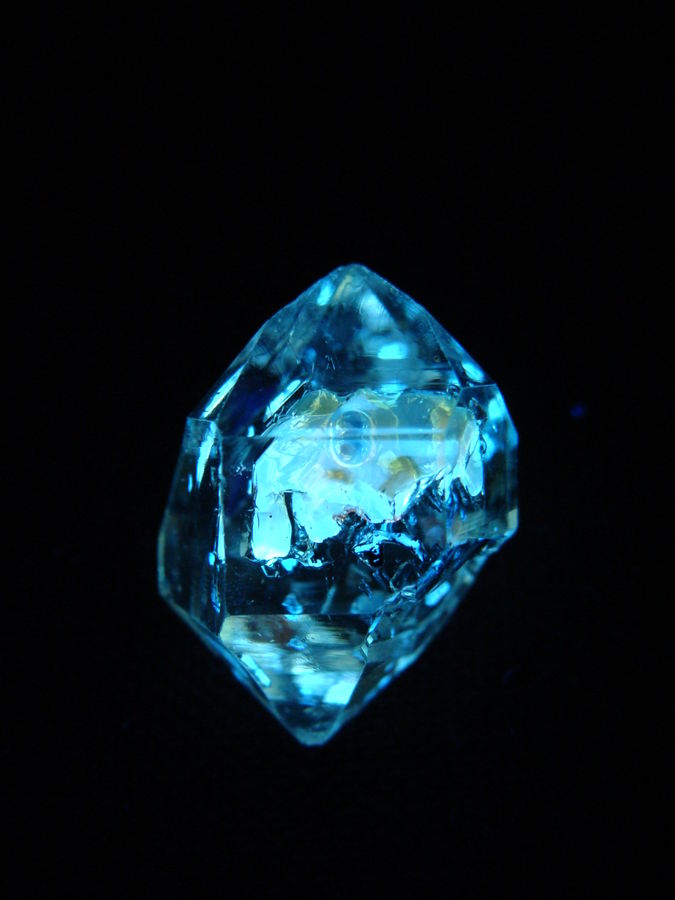
|
|
|
| Back to top |
|
 |
cascaillou
Joined: 27 Nov 2011
Posts: 263


|
 Posted: Jun 02, 2017 05:55 Post subject: Re: Quartz Inclusions Posted: Jun 02, 2017 05:55 Post subject: Re: Quartz Inclusions |
|
|
addon:
I insist that the bubble within the petroleum phase is gas, not water (as negative crystals contain both a yellow petroleum phase, and an immiscible water phase (colorless), but the moving bubble within the petroleum phase just won't merge with the water phase)
|
|
| Back to top |
|
 |
zbhjzm
Joined: 18 Dec 2016
Posts: 163


|
 Posted: Oct 08, 2017 05:12 Post subject: Re: Quartz Inclusions Posted: Oct 08, 2017 05:12 Post subject: Re: Quartz Inclusions |
|
|
HI all,
As I posted in the topic below earlier:
https://www.mineral-forum.com/message-board/viewtopic.php?t=5265
I got this quartz with blue inclusions. Most of the inclusions are solid,but some isolated chambers with blue fluid and bubbles can be found under microscope.This suggests that it can not be dyed by man.
However,the blue inclusions turn red under Chelsea filter and have a visible absorption spectrum quite similar to cobalt glass's.
Does cobalt fluid really exist in nature? Or ,it's something else?
Please help me solve this mystery.
| Description: |
|
| Viewed: |
32743 Time(s) |
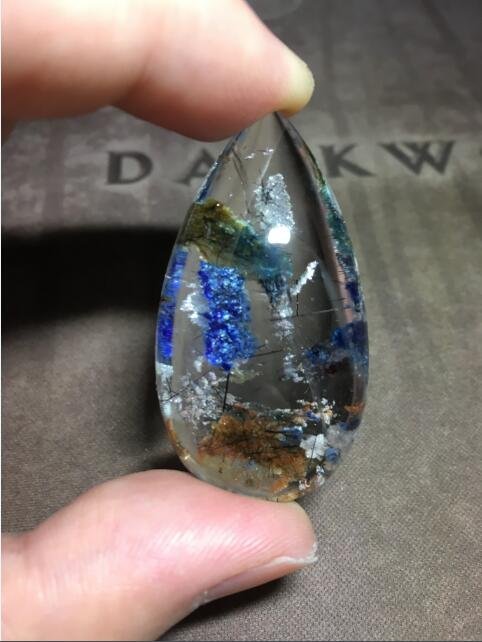
|
| Description: |
|
| Viewed: |
32767 Time(s) |
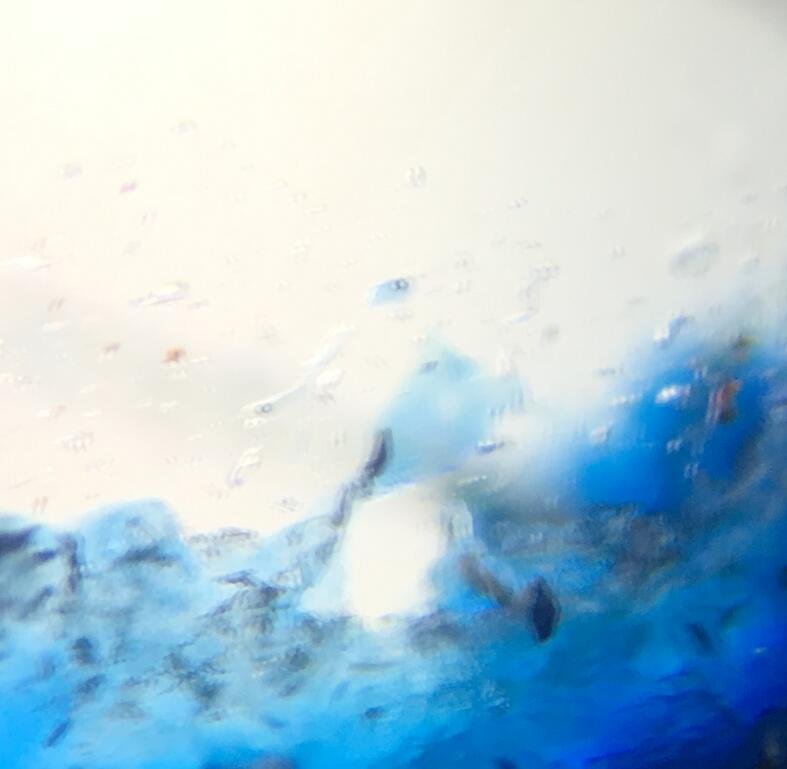
|
| Description: |
|
| Viewed: |
32784 Time(s) |
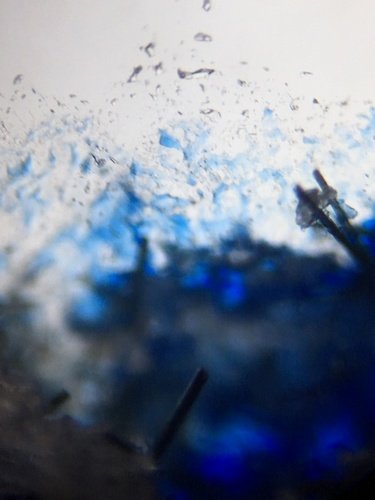
|
| Description: |
|
| Viewed: |
32754 Time(s) |
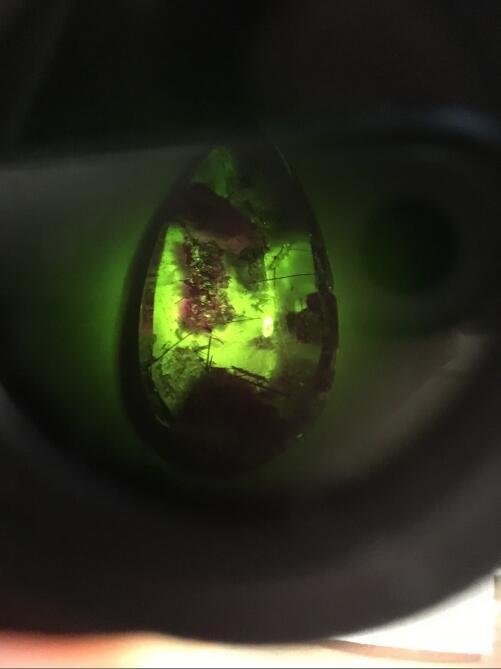
|
| Description: |
|
| Viewed: |
32715 Time(s) |
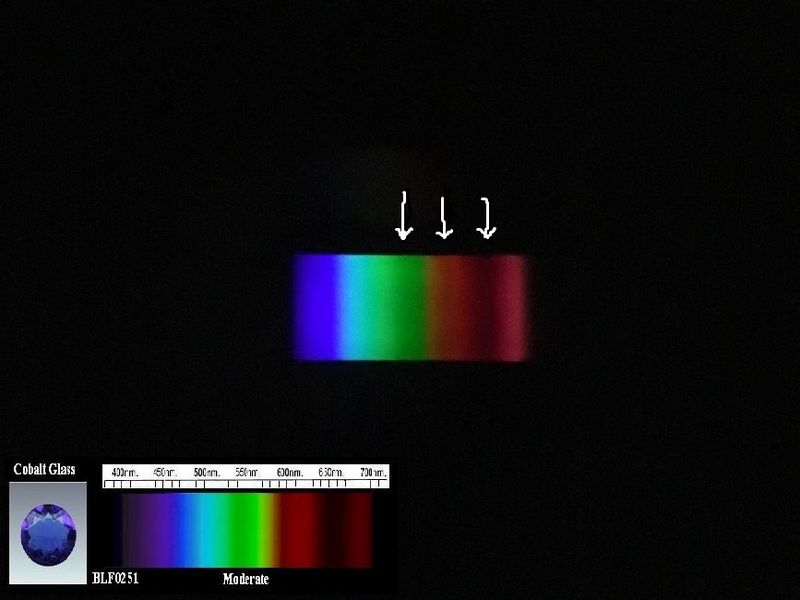
|
|
|
| Back to top |
|
 |
Peter Lemkin
Joined: 18 Nov 2016
Posts: 403
Location: Prague


|
 Posted: Oct 08, 2017 07:27 Post subject: Re: Quartz Inclusions Posted: Oct 08, 2017 07:27 Post subject: Re: Quartz Inclusions |
|
|
| Get the Hyrsl & Neidemayr book on inclusions in quartz. They list just about everything. I'm no expert on this, though I have the book. My guesstimation is this may be man-made - even if pure Si02. As it is polished, one can not see any faces to prove it is natural quartz. The Chinese have been making a lot of strange, if attractive, man-made 'minerals' even with bubbles and fluid inclusions. On the other hand perhaps it is natural and just very unusual. Maybe you can interest some university to do some sophisticated tests. Ramen spectrography is the hot new thing - but there are plenty of other tests that use equipment few of us have in our homes or garages. Just looked in their book and they list no Co compounds - although there are a lot of blue inclusions. And if you have a really good geological library at hand the ultimate book is the three volume 1500 page Photoatlas of Inclusions in Gemstones published by GIA!
|
|
| Back to top |
|
 |
zbhjzm
Joined: 18 Dec 2016
Posts: 163


|
 Posted: Oct 08, 2017 10:32 Post subject: Re: Quartz Inclusions Posted: Oct 08, 2017 10:32 Post subject: Re: Quartz Inclusions |
|
|
| Peter Lemkin wrote: | | Get the Hyrsl & Neidemayr book on inclusions in quartz. They list just about everything. I'm no expert on this, though I have the book. My guessimation is this may be man-made - even if pure Si02. As it is polished, one can not see any faces to prove it is natural quartz. The Chinese have been making a lot of strange, if attractive, man-made 'minerals' even with bubbles and fluid inclusions. On the other hand perhaps it is natural and just very unusual. Maybe you can interest some university to do some sophisticated tests. Ramen spectrography is the hot new thing - but there are plenty of other tests that use equipment few of us have in our homes or garages. Just looked in their book and they list no Co compounds - although there are a lot of blue inclusions. And if you have a really good geological library at hand the ultimate book is the three volume 1500 page Photoatlas of Inclusions in Gemstones published by GIA! |
Thanks a lot!
I'll see if I can find those books in a library.
|
|
| Back to top |
|
 |
zbhjzm
Joined: 18 Dec 2016
Posts: 163


|
 Posted: Oct 16, 2017 13:59 Post subject: Re: Quartz Inclusions Posted: Oct 16, 2017 13:59 Post subject: Re: Quartz Inclusions |
|
|
| Peter Lemkin wrote: | | Get the Hyrsl & Neidemayr book on inclusions in quartz. They list just about everything. I'm no expert on this, though I have the book. My guesstimation is this may be man-made - even if pure Si02. As it is polished, one can not see any faces to prove it is natural quartz. The Chinese have been making a lot of strange, if attractive, man-made 'minerals' even with bubbles and fluid inclusions. On the other hand perhaps it is natural and just very unusual. Maybe you can interest some university to do some sophisticated tests. Ramen spectrography is the hot new thing - but there are plenty of other tests that use equipment few of us have in our homes or garages. Just looked in their book and they list no Co compounds - although there are a lot of blue inclusions. And if you have a really good geological library at hand the ultimate book is the three volume 1500 page Photoatlas of Inclusions in Gemstones published by GIA! |
Hi Peter,
I haven't found the books yet, but I have found blue fluid inclusions in another specimen and this one sure looks natural.
| Description: |
|
| Viewed: |
8109 Time(s) |
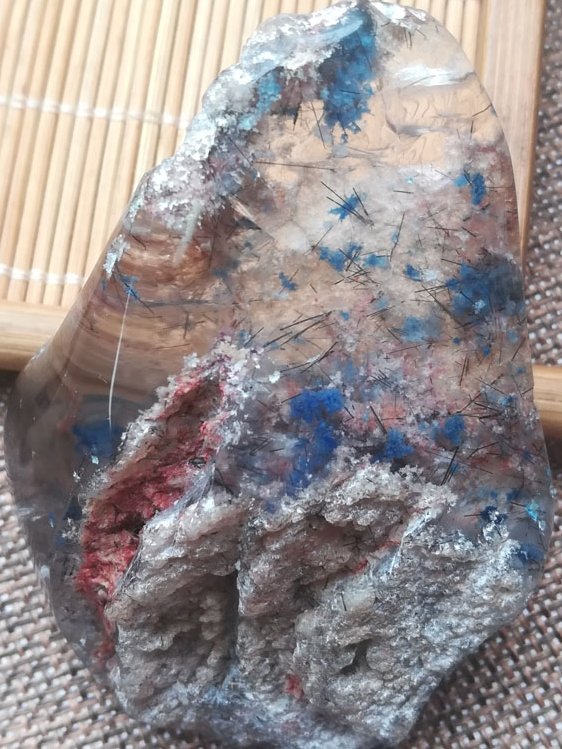
|
| Description: |
|
| Viewed: |
8106 Time(s) |
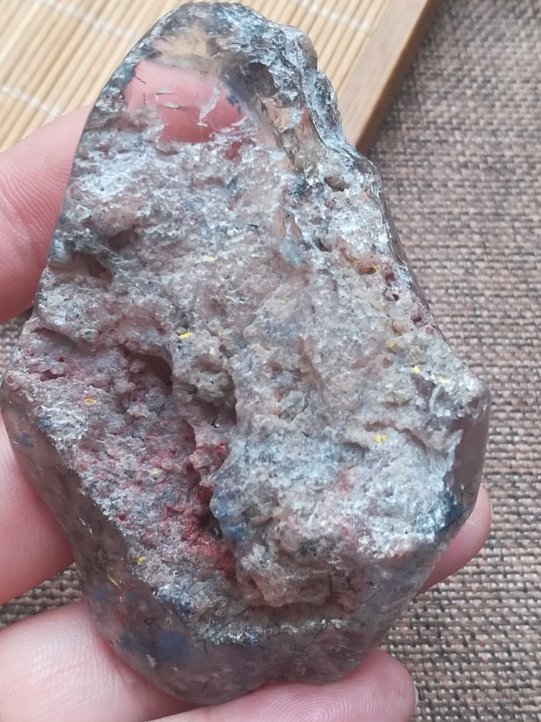
|
| Description: |
|
| Viewed: |
8125 Time(s) |
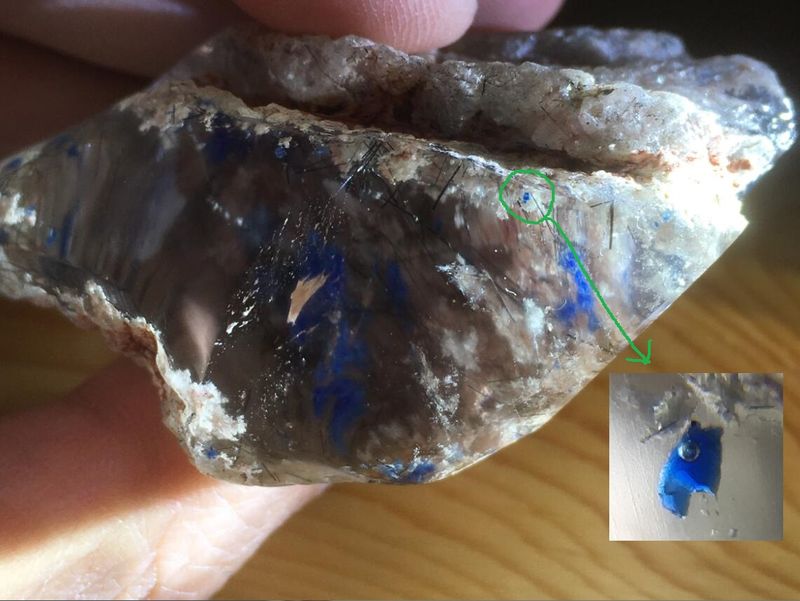
|
|
|
| Back to top |
|
 |
|





